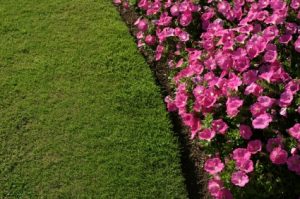 Lawn & Landscape Numbers: How To Calculate The Square Footage Of Your Lawn
Lawn & Landscape Numbers: How To Calculate The Square Footage Of Your Lawn
The 2015 circle of life is complete and it’s on to a new year. Now is the time to get ready for the lawn and landscape duties for 2016. The first number that every home owner needs to know is the total square footage of the lawn, perennial landscape beds and annual beds. Do not include walk ways, drive ways, patios, swimming pools, etc.
The following is how to find this number. First, make a sketch of the lot and house. Divide the lawn and bed areas into section. Measure one section at a time and write the number down. A tape measure and another person is the best way to measure the outside of an area. If you are the only one doing this then you need to pace it off. For this you need to measure the distance of your step. Most folks are 2.5 to 3.5 feet per step. Count the steps and multiply by that number and you have the measurement. For curvy landscape edging just measure it as if it was straight. Once you have the dimensions find the total of multiplying length and width. Example: 36’ (L) x48’ (W) =1,728 square feet. Do this for each section and add them together and you have the total square footage your lawn and beds. If you would like bring in the measurements and we will figure it out for you.
Remember that the square footage of a lawn doesn’t have to be to the inch but should be within 10 to 20 square feet. Landscape and annual (garden) beds should be measured to within 5 square feet. If all this sounds like a lot of work, it’s really not. This is one of those chores that is done once per house, unless you change landscaping or lose the piece of paper with the number. The last tip is to write this number on the inside of the garage wall with a Sharpie. You are now hard pressed to lose this number.
The next number is actually a series of number. These numbers reflect the current nutritional state of the soil. I’m talking soil test. Soil tests should be done every 5 years or so for lawns. A soil test gives you a map of your soil nutrition level. Three places to get soil testing done are Wells Brothers, Texas A&M and Texas Plants and Soil Labs. Wells Brothers does nutritional testing only. TA&M and TPSL does nutritional as well as contamination soil testing. With this information you can then purchase specific or have custom fertilizer made to fit a specific analysis.
Fertilizers are everywhere but you should make your selection carefully. If you decide you need a specific fertilizer, give Wells Brothers a call. We have a wide selection of macro and micro nutrients that we sell by the pound. We can also mix fertilizers to fit most requirements for our area of the planet.
Macronutrients:
46 % Nitrogen (N) – $1.50 lbs.
46% Phosphorus (P) – $1.25 lbs.
Potassium (K) w/17 %( S) – $2.40 lbs.
90% Sulfur (S) – $1.00 lbs.
Micronutrients:
10% Boron (B) – $4.00 lbs.
50% Iron (Fe) – $1.75 lbs.
28% Manganese (Mn) – $2.25 lbs.
20% Zinc (Zn) – $2.00 lbs.
*Trace Mineral Mix – $4.50 lbs.
*Boron – 2%, Copper – 5%, Iron – 10%, Manganese – 5%, Molybdenum – .05%, Zinc – 5%.





